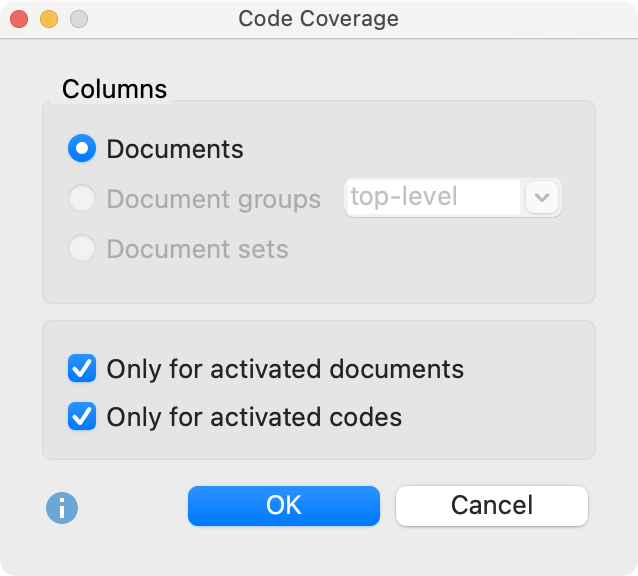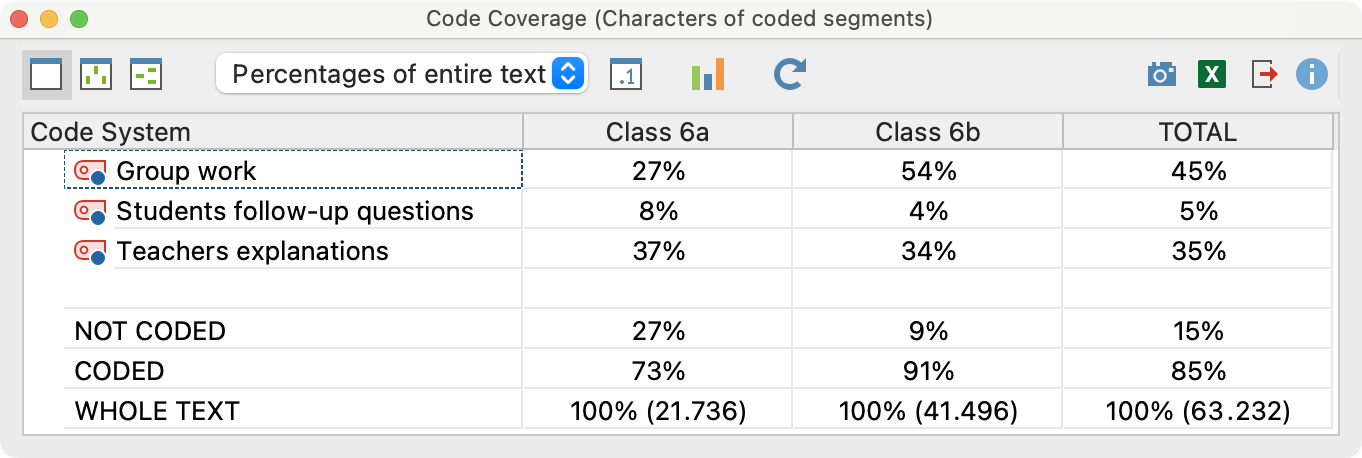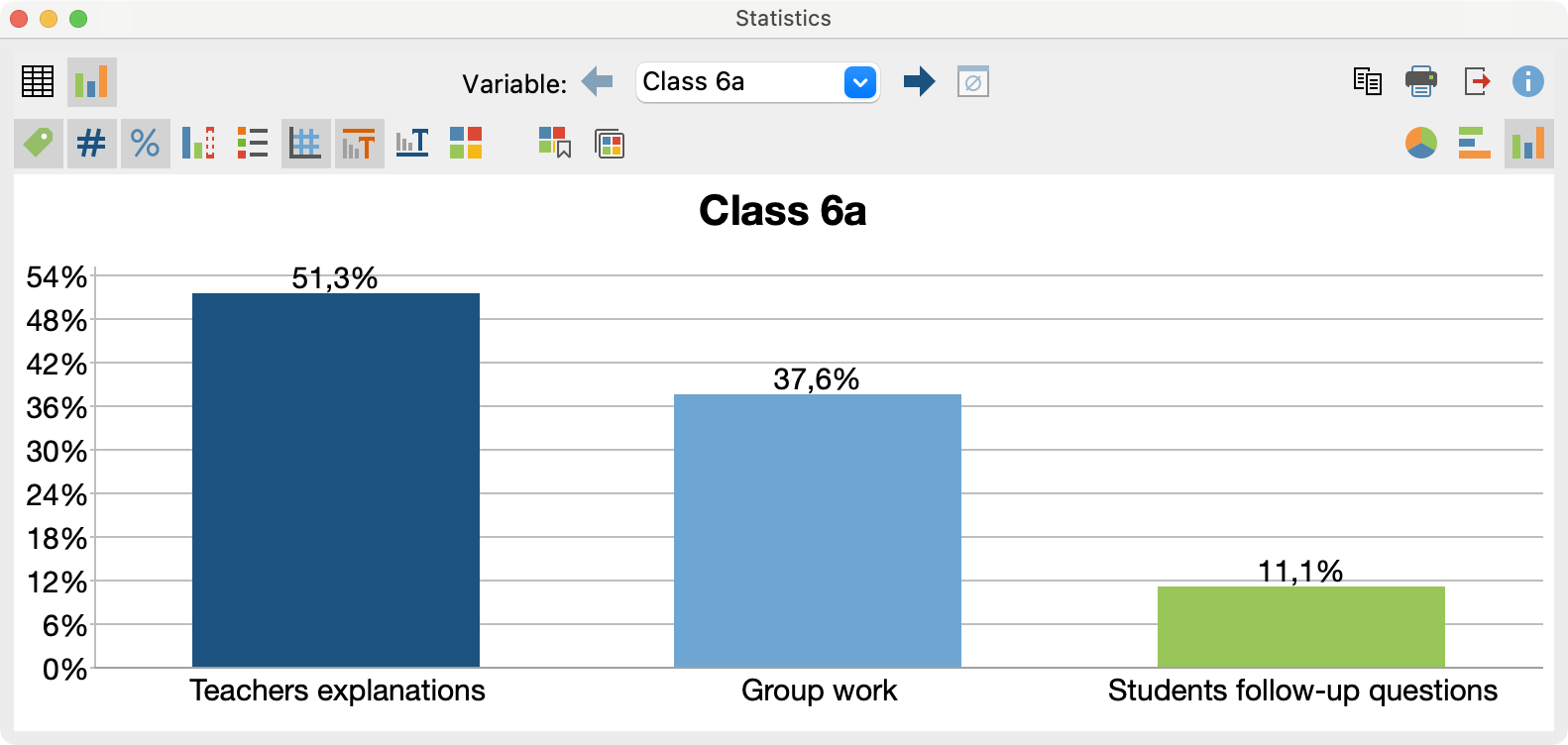With the help of the Code Coverage function, you can analyze to what extent the document has been coded with a particular code. Code Coverage comparisons can be applied to multiple documents, document groups, and document sets. The tool compares coded characters (including spaces) in texts, coded areas in images, and coded time in videos.
Starting the function
Follow these steps to determine Code Coverage:
- First, activate the documents and the codes that you want to include in the analysis. If you want to analyze all documents and all codes, you do not need to activate anything.
- Click on the Code Coverage function in the Analysis menu and select in the appearing menu whether you want to analyze (a) texts, tables or PDF documents (b) images, or (c) videos.

- The following dialog window will then appear in which you can choose to split the results by document, document group, or document set.

The results table for two coded documents, for example, could look like this:

The results table displays the documents, document groups, or document sets in the columns, and the selected codes in the rows. By default, the cells provide information about how much area in a document is coded with a code (in percent). In the example above, you can see that 50% of text in “Class 6a” was coded with the code “Group work”, whereas in “Class 6b” this percentage is only 34%. The drop-down menu allows you to define what results are displayed in the cells:
Percentages: none – the absolute numbers are displayed, i.e., the coded characters including spaces (in texts), the coded area (for pictures), or the coded time (for videos).
Percentages of “coded“ – the result cells indicate what percentage of the coded length, area, time of the document was coded with the given code. The sum of the percentages will exceed 100% if the analyzed codes overlap each other at one or more points in the document.
Percentages of entire text/image/video – the result cells indicate what percentage of the coded length, area, time of the document was coded with the given code. The sum of the percentages will exceed 100% if the analyzed codes overlap each other at one or more points in the document.
Row percentages – the result cells indicate what percentage of all evaluated documents, document groups, or document sets have been coded with each respective code. Each row then indicates how the coded segments are distributed as a percentage of the individual documents, groups, or sets.
The three rows on the bottom end of the table are always displayed and contain the following information:
NOT CODED – provides the length/area/time of the document, group, or set that has been coded with none of the currently displayed codes.
CODED – provides the length/area/time that has been coded with any of the currently displayed codes.
TOTAL TEXT/AREA/TIME – provides the total extent of the document, document group, or document set.
Functions in the toolbar
A toolbar with the following functions is located at the top of the "Code Coverage" window:
![]() No color highlight – turns off color highlighting of the result cells.
No color highlight – turns off color highlighting of the result cells.
![]() Color highlight refers to columns – the cells in each column with the highest value is dark green, that with the smallest is white. The closer a value is to the highest value, the darker its green highlight.
Color highlight refers to columns – the cells in each column with the highest value is dark green, that with the smallest is white. The closer a value is to the highest value, the darker its green highlight.
![]() Color highlight refers to rows – the cells in each row with the highest value is dark green, that with the smallest is white. The closer a value is to the highest value, the darker its green highlight.
Color highlight refers to rows – the cells in each row with the highest value is dark green, that with the smallest is white. The closer a value is to the highest value, the darker its green highlight.
![]() Show decimals – for easier readability of the percentages, decimal places are switched off by default and can be displayed via this symbol.
Show decimals – for easier readability of the percentages, decimal places are switched off by default and can be displayed via this symbol.
![]() Chart view – creates a frequency table with the calculated values for each column. The frequency table can be turned into a diagram to visualize these results.
Chart view – creates a frequency table with the calculated values for each column. The frequency table can be turned into a diagram to visualize these results.
Store Results Table in a QTT Worksheet
In the Questions – Themes – Theories (QTT) workspace of MAXQDA, you can collect and comment on all the important results of your project. To save the results table in an existing or new worksheet in the QTT workspace, you can use the ![]() Send to QTT Worksheet icon in the upper right corner in the toolbar.
Send to QTT Worksheet icon in the upper right corner in the toolbar.
Exporting results tables
The current view of the result table can be exported using the usual icons on top right of the window. When the highlight is turn on, this is also included.
![]() Copy current display as an image to clipboard – copies the currently visible table as a graphic to the clipboard so it can be pasted directly into a publications or presentation.
Copy current display as an image to clipboard – copies the currently visible table as a graphic to the clipboard so it can be pasted directly into a publications or presentation.
![]() Export – MAXQDA creates a spreadsheet as an Excel file (XLSX format), as a webpage (HTML format) or as a text document (Word or RTF format) after you have entered filename and location. Export as a graphic file is also possible.
Export – MAXQDA creates a spreadsheet as an Excel file (XLSX format), as a webpage (HTML format) or as a text document (Word or RTF format) after you have entered filename and location. Export as a graphic file is also possible.
Displaying results tables as a chart
Your results can be displayed as frequency table or as a chart. In the "Percentage" column, the percentages are displayed relative to the total area, in the column "Percent (Valid)" relative to the coded area.
Clicking on the diagram symbols above the frequency table show a vertical or horizontal bar chart, or a pie chart. By activating the missing values, the graphic figures show the percentages related to the total area.

Refer to section Frequency Tables and Charts for Subcodes for information on creating and customizing charts.
